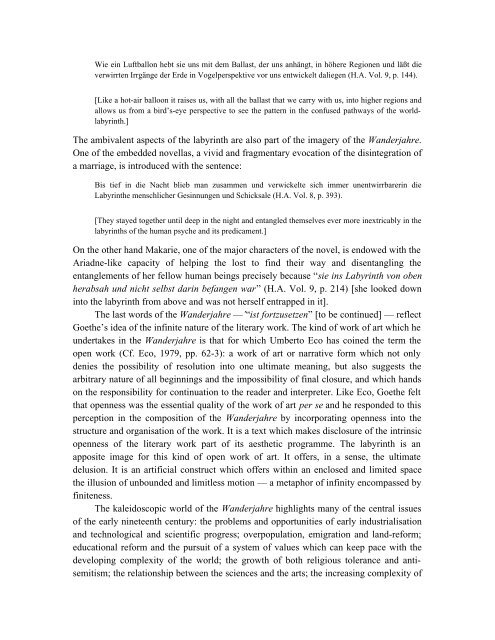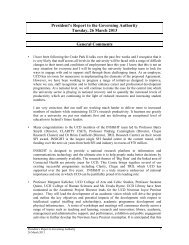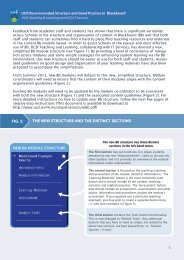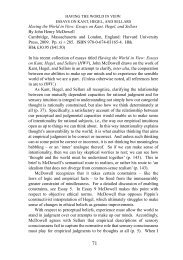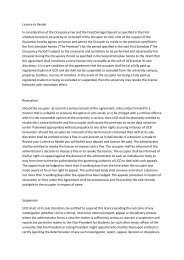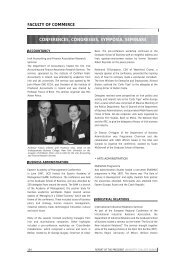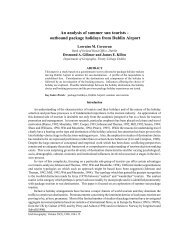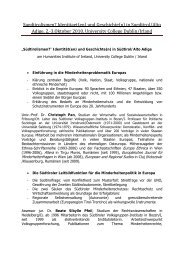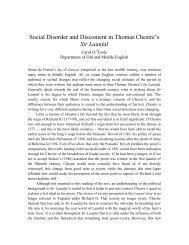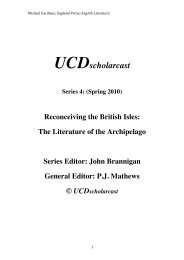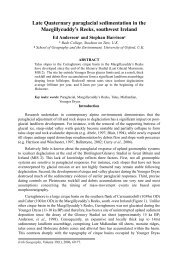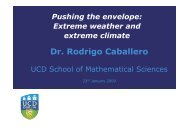Weaving the labyrinth of the text — the novel poetics of Goethe's ...
Weaving the labyrinth of the text — the novel poetics of Goethe's ...
Weaving the labyrinth of the text — the novel poetics of Goethe's ...
You also want an ePaper? Increase the reach of your titles
YUMPU automatically turns print PDFs into web optimized ePapers that Google loves.
Wie ein Luftballon hebt sie uns mit dem Ballast, der uns anhängt, in höhere Regionen und läßt die<br />
verwirrten Irrgänge der Erde in Vogelperspektive vor uns entwickelt daliegen (H.A. Vol. 9, p. 144).<br />
[Like a hot-air balloon it raises us, with all <strong>the</strong> ballast that we carry with us, into higher regions and<br />
allows us from a bird’s-eye perspective to see <strong>the</strong> pattern in <strong>the</strong> confused pathways <strong>of</strong> <strong>the</strong> world<strong>labyrinth</strong>.]<br />
The ambivalent aspects <strong>of</strong> <strong>the</strong> <strong>labyrinth</strong> are also part <strong>of</strong> <strong>the</strong> imagery <strong>of</strong> <strong>the</strong> Wanderjahre.<br />
One <strong>of</strong> <strong>the</strong> embedded <strong>novel</strong>las, a vivid and fragmentary evocation <strong>of</strong> <strong>the</strong> disintegration <strong>of</strong><br />
a marriage, is introduced with <strong>the</strong> sentence:<br />
Bis tief in die Nacht blieb man zusammen und verwickelte sich immer unentwirrbarerin die<br />
Labyrin<strong>the</strong> menschlicher Gesinnungen und Schicksale (H.A. Vol. 8, p. 393).<br />
[They stayed toge<strong>the</strong>r until deep in <strong>the</strong> night and entangled <strong>the</strong>mselves ever more inextricably in <strong>the</strong><br />
<strong>labyrinth</strong>s <strong>of</strong> <strong>the</strong> human psyche and its predicament.]<br />
On <strong>the</strong> o<strong>the</strong>r hand Makarie, one <strong>of</strong> <strong>the</strong> major characters <strong>of</strong> <strong>the</strong> <strong>novel</strong>, is endowed with <strong>the</strong><br />
Ariadne-like capacity <strong>of</strong> helping <strong>the</strong> lost to find <strong>the</strong>ir way and disentangling <strong>the</strong><br />
entanglements <strong>of</strong> her fellow human beings precisely because “sie ins Labyrinth von oben<br />
herabsah und nicht selbst darin befangen war” (H.A. Vol. 9, p. 214) [she looked down<br />
into <strong>the</strong> <strong>labyrinth</strong> from above and was not herself entrapped in it].<br />
The last words <strong>of</strong> <strong>the</strong> Wanderjahre <strong>—</strong>’“ist fortzusetzen” [to be continued] <strong>—</strong> reflect<br />
Goe<strong>the</strong>’s idea <strong>of</strong> <strong>the</strong> infinite nature <strong>of</strong> <strong>the</strong> literary work. The kind <strong>of</strong> work <strong>of</strong> art which he<br />
undertakes in <strong>the</strong> Wanderjahre is that for which Umberto Eco has coined <strong>the</strong> term <strong>the</strong><br />
open work (Cf. Eco, 1979, pp. 62-3): a work <strong>of</strong> art or narrative form which not only<br />
denies <strong>the</strong> possibility <strong>of</strong> resolution into one ultimate meaning, but also suggests <strong>the</strong><br />
arbitrary nature <strong>of</strong> all beginnings and <strong>the</strong> impossibility <strong>of</strong> final closure, and which hands<br />
on <strong>the</strong> responsibility for continuation to <strong>the</strong> reader and interpreter. Like Eco, Goe<strong>the</strong> felt<br />
that openness was <strong>the</strong> essential quality <strong>of</strong> <strong>the</strong> work <strong>of</strong> art per se and he responded to this<br />
perception in <strong>the</strong> composition <strong>of</strong> <strong>the</strong> Wanderjahre by incorporating openness into <strong>the</strong><br />
structure and organisation <strong>of</strong> <strong>the</strong> work. It is a <strong>text</strong> which makes disclosure <strong>of</strong> <strong>the</strong> intrinsic<br />
openness <strong>of</strong> <strong>the</strong> literary work part <strong>of</strong> its aes<strong>the</strong>tic programme. The <strong>labyrinth</strong> is an<br />
apposite image for this kind <strong>of</strong> open work <strong>of</strong> art. It <strong>of</strong>fers, in a sense, <strong>the</strong> ultimate<br />
delusion. It is an artificial construct which <strong>of</strong>fers within an enclosed and limited space<br />
<strong>the</strong> illusion <strong>of</strong> unbounded and limitless motion <strong>—</strong> a metaphor <strong>of</strong> infinity encompassed by<br />
finiteness.<br />
The kaleidoscopic world <strong>of</strong> <strong>the</strong> Wanderjahre highlights many <strong>of</strong> <strong>the</strong> central issues<br />
<strong>of</strong> <strong>the</strong> early nineteenth century: <strong>the</strong> problems and opportunities <strong>of</strong> early industrialisation<br />
and technological and scientific progress; overpopulation, emigration and land-reform;<br />
educational reform and <strong>the</strong> pursuit <strong>of</strong> a system <strong>of</strong> values which can keep pace with <strong>the</strong><br />
developing complexity <strong>of</strong> <strong>the</strong> world; <strong>the</strong> growth <strong>of</strong> both religious tolerance and antisemitism;<br />
<strong>the</strong> relationship between <strong>the</strong> sciences and <strong>the</strong> arts; <strong>the</strong> increasing complexity <strong>of</strong>


